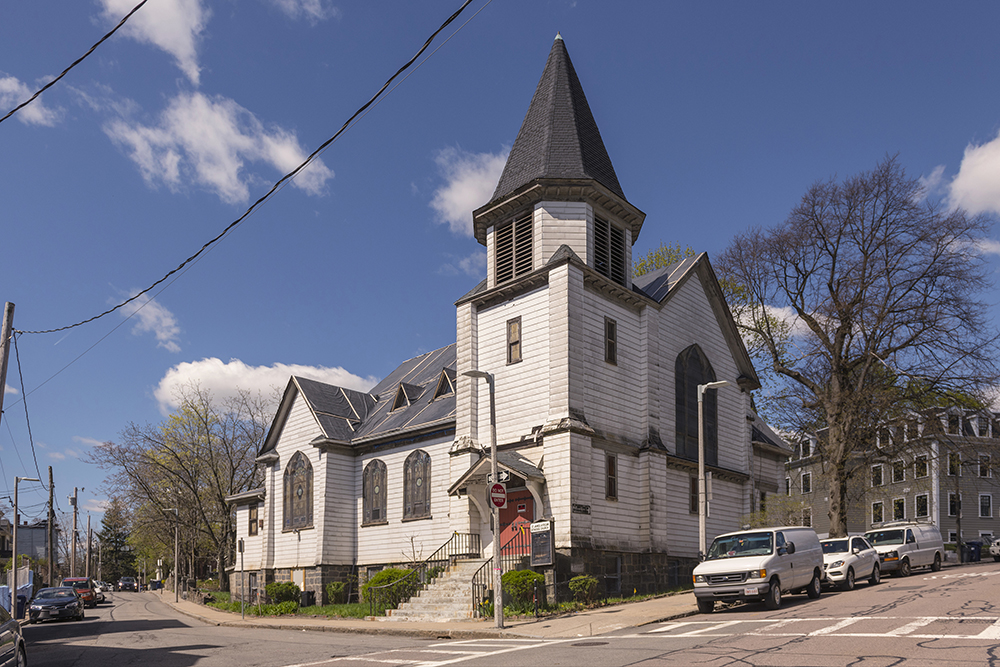
Roxbury, MA Historic Boston Inc. (HBI), the nonprofit preservation organization, has sold the historic St. James African Orthodox Church.
The church, located at 50 Cedar St. and formerly a center of Black activism in Boston, will become the new home of the long-time Boston African American organization and space for other community-focused organizations in the Highland Park neighborhood.
The building, two and a half stories tall with a tower, is important for its associations with two phases of immigration to Boston and for its associations with 20th century civil rights and social justice. It is both listed as a Boston Landmark and on the National Register of Historic Places within the Roxbury Highlands Historic District.
“Thanks to the community’s mobilization and advocacy and HBI’s acquisition, the building is saved and protected and is positioned to be a wonderful community asset and a beautifully preserved historic place for Roxbury’s future,” said Kathy Kottaridis, executive director of Historic Boston. “We appreciate the all-critical organizing and advocacy undertaken by the Highland Park Neighborhood in the effort to save St. James, and the care with which the neighborhood has approached the building’s reuse.”
The sale was completed in July. It has been under agreement with RAP for almost a year, but the sale was delayed pending the city of Boston’s placement of a historic preservation restriction on the property, which enhances the existing Boston Landmark designation.
“RAP has such a long history of projects like St. James,” RAP president Malcolm Wynn said late last year. “We are excited to be bringing this building back into the life of our community.”
The 8,000 s/f wood frame building was designed by architect Edward T.P. Graham and built in 1910 for a Norwegian Evangelical congregation. In 1955, it changed hands and became the African Orthodox Church, as the area gained Black residents. The church fit the needs of the African Orthodox community, an offshoot of Jamaican-born Black Nationalist Marcus Garvey’s Universal Negro Improvement Association.
Historic Boston bought the property for $1.4 million in 2018 from developer City Realty with $500,000 in assistance from the city’s community preservation committee and the Boston city council. The company had sought the church’s demolition to make way for new housing. It had been vacant since 2015, when the building was sold by its last remaining members.
St. James was in poor condition from years of neglect, but its rich history and architecture became a rallying point for neighborhood residents, who mobilized to collect more than 2,500 signatures to promote its protection as a Boston Landmark.
Then-mayor Martin Walsh asked the Suffolk Superior Court to issue an injunction, delaying demolition long enough for Historic Boston to negotiate a purchase. HBI repaired deteriorated floor structures, secured windows and doors, and undertook an assessment of building conditions. HBI also replaced the roof of the church and repaired its structure in order to prevent further water damage.
HBI was assisted not only by the city of Boston Community Preservation Program but also by The Life Initiative, a community investment fund created in 1999 by Massachusetts-based life insurance companies, for financing. Assistance for the property’s stabilization and repair also was provided by the Harold Whitworth Pierce Charitable Trust, the 1772 Foundation and the Robert Kuehn Foundation.
HBI considered several possible reuses, including affordable housing, but those efforts were vigorously opposed by a few neighbors. The Roxbury Action Program’s consultants are again assessing the condition of the building and evaluating various community-supporting uses.
Those include RAP’s own headquarters and offices, nonprofit offices and incubator space on the ground floor.
“HBI looks forward to assisting RAP with its plans at St. James and their stewardship of this important site,” said Kottaridis.
Early History
Architect Graham’s design features a blend of Shingle and Late Gothic Revival architectural elements. In its early years, the church served small pockets of Norwegian immigrants in Boston who worked in manufacturing and the fishing industry. By 1955, the demographics of the neighborhood had changed, and the African Orthodox Church purchased the building.
It was founded decades earlier by George Alexander McGuire, the former Chaplin-general of Garvey’s Universal Negro Improvement Association. In 1918, Garvey met McGuire, a young priest who had immigrated from Antigua in 1894 and a student at the Moravian Miskey Seminary in the Danish West Indies. Both shared visions of an African diaspora that would draw strength from their shared Pan-African heritage and wield that power to demand racial equality.
In September of 1921, after two years with Garvey’s organization as the Chaplain-General, McGuire started his own church, The Independent Episcopal Church, which would become the roots for the African Orthodox Church and would serve a congregation of black-nationalist neo-Anglican members around the country.
Firmly rooted in the Garvey movement and racial autonomy, the church fostered a sense of self-determinism among the growing Black population of Roxbury throughout the 1960s, ‘70s, and ‘80s. By 2011, the church congregation had dwindled and was no longer able to care for the aging building.
